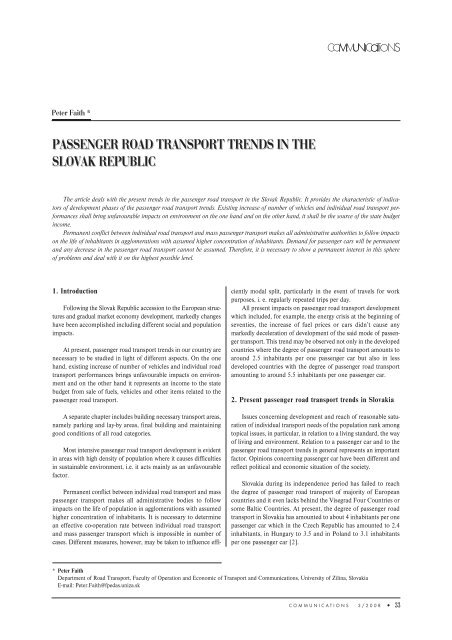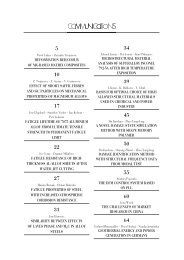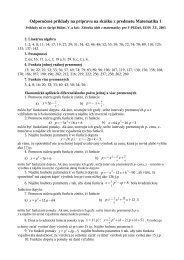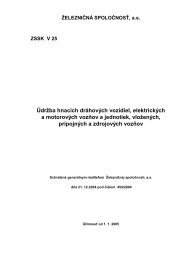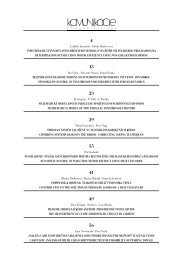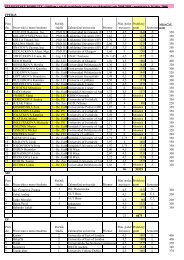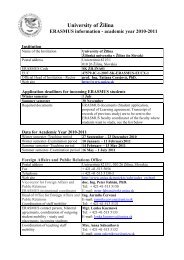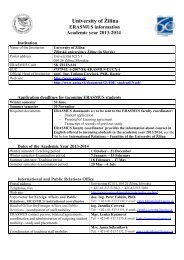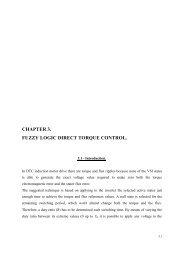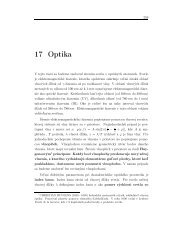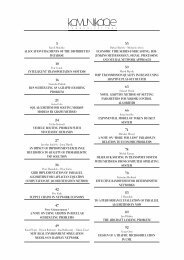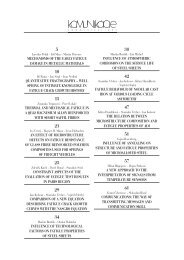simulation of torsion moment at the wheel set of the railway vehicle ...
simulation of torsion moment at the wheel set of the railway vehicle ...
simulation of torsion moment at the wheel set of the railway vehicle ...
You also want an ePaper? Increase the reach of your titles
YUMPU automatically turns print PDFs into web optimized ePapers that Google loves.
Peter Faith *PASSENGER ROAD TRANSPORT TRENDS IN THESLOVAK REPUBLICThe article deals with <strong>the</strong> present trends in <strong>the</strong> passenger road transport in <strong>the</strong> Slovak Republic. It provides <strong>the</strong> characteristic <strong>of</strong> indic<strong>at</strong>ors<strong>of</strong> development phases <strong>of</strong> <strong>the</strong> passenger road transport trends. Existing increase <strong>of</strong> number <strong>of</strong> <strong>vehicle</strong>s and individual road transport performancesshall bring unfavourable impacts on environment on <strong>the</strong> one hand and on <strong>the</strong> o<strong>the</strong>r hand, it shall be <strong>the</strong> source <strong>of</strong> <strong>the</strong> st<strong>at</strong>e budgetincome.Permanent conflict between individual road transport and mass passenger transport makes all administr<strong>at</strong>ive authorities to follow impactson <strong>the</strong> life <strong>of</strong> inhabitants in agglomer<strong>at</strong>ions with assumed higher concentr<strong>at</strong>ion <strong>of</strong> inhabitants. Demand for passenger cars will be permanentand any decrease in <strong>the</strong> passenger road transport cannot be assumed. Therefore, it is necessary to show a permanent interest in this sphere<strong>of</strong> problems and deal with it on <strong>the</strong> highest possible level.1. IntroductionFollowing <strong>the</strong> Slovak Republic accession to <strong>the</strong> European structuresand gradual market economy development, markedly changeshave been accomplished including different social and popul<strong>at</strong>ionimpacts.At present, passenger road transport trends in our country arenecessary to be studied in light <strong>of</strong> different aspects. On <strong>the</strong> onehand, existing increase <strong>of</strong> number <strong>of</strong> <strong>vehicle</strong>s and individual roadtransport performances brings unfavourable impacts on environmentand on <strong>the</strong> o<strong>the</strong>r hand it represents an income to <strong>the</strong> st<strong>at</strong>ebudget from sale <strong>of</strong> fuels, <strong>vehicle</strong>s and o<strong>the</strong>r items rel<strong>at</strong>ed to <strong>the</strong>passenger road transport.A separ<strong>at</strong>e chapter includes building necessary transport areas,namely parking and lay-by areas, final building and maintaininggood conditions <strong>of</strong> all road c<strong>at</strong>egories.Most intensive passenger road transport development is evidentin areas with high density <strong>of</strong> popul<strong>at</strong>ion where it causes difficultiesin sustainable environment, i.e. it acts mainly as an unfavourablefactor.Permanent conflict between individual road transport and masspassenger transport makes all administr<strong>at</strong>ive bodies to followimpacts on <strong>the</strong> life <strong>of</strong> popul<strong>at</strong>ion in agglomer<strong>at</strong>ions with assumedhigher concentr<strong>at</strong>ion <strong>of</strong> inhabitants. It is necessary to determinean effective co-oper<strong>at</strong>ion r<strong>at</strong>e between individual road transportand mass passenger transport which is impossible in number <strong>of</strong>cases. Different measures, however, may be taken to influence efficientlymodal split, particularly in <strong>the</strong> event <strong>of</strong> travels for workpurposes, i. e. regularly repe<strong>at</strong>ed trips per day.All present impacts on passenger road transport developmentwhich included, for example, <strong>the</strong> energy crisis <strong>at</strong> <strong>the</strong> beginning <strong>of</strong>seventies, <strong>the</strong> increase <strong>of</strong> fuel prices or cars didn’t cause anymarkedly deceler<strong>at</strong>ion <strong>of</strong> development <strong>of</strong> <strong>the</strong> said mode <strong>of</strong> passengertransport. This trend may be observed not only in <strong>the</strong> developedcountries where <strong>the</strong> degree <strong>of</strong> passenger road transport amounts toaround 2.5 inhabitants per one passenger car but also in lessdeveloped countries with <strong>the</strong> degree <strong>of</strong> passenger road transportamounting to around 5.5 inhabitants per one passenger car.2. Present passenger road transport trends in SlovakiaIssues concerning development and reach <strong>of</strong> reasonable s<strong>at</strong>ur<strong>at</strong>ion<strong>of</strong> individual transport needs <strong>of</strong> <strong>the</strong> popul<strong>at</strong>ion rank amongtopical issues, in particular, in rel<strong>at</strong>ion to a living standard, <strong>the</strong> way<strong>of</strong> living and environment. Rel<strong>at</strong>ion to a passenger car and to <strong>the</strong>passenger road transport trends in general represents an importantfactor. Opinions concerning passenger car have been different andreflect political and economic situ<strong>at</strong>ion <strong>of</strong> <strong>the</strong> society.Slovakia during its independence period has failed to reach<strong>the</strong> degree <strong>of</strong> passenger road transport <strong>of</strong> majority <strong>of</strong> Europeancountries and it even lacks behind <strong>the</strong> Visegrad Four Countries orsome Baltic Countries. At present, <strong>the</strong> degree <strong>of</strong> passenger roadtransport in Slovakia has amounted to about 4 inhabitants per onepassenger car which in <strong>the</strong> Czech Republic has amounted to 2.4inhabitants, in Hungary to 3.5 and in Poland to 3.1 inhabitantsper one passenger car [2].* Peter FaithDepartment <strong>of</strong> Road Transport, Faculty <strong>of</strong> Oper<strong>at</strong>ion and Economic <strong>of</strong> Transport and Communic<strong>at</strong>ions, University <strong>of</strong> Zilina, SlovakiaE-mail: Peter.Faith@fpedas.uniza.skCOMMUNICATIONS 3/2008 ●33


